Tips for working with images in Publisher
Pictures have power on the page — the power to grab your readers' attention and to convey or enhance your message. Pictures help readers find entry points into the text. They give readers a quick summary of what the text is about and help grasp complex ideas.
Pictures can relieve the tedium of gray type. But they can also distract from your message if pictures don't relate closely to the message. Make sure you control your message with the pictures in your publication.
What do you want to do?
Enhance your message with pictures
When you create or select images for a publication, make them:
-
Relevant Use pictures to clarify key concepts. Because readers skim pages by reading headlines and picture captions, you can help readers glean your most important messages by reinforcing messages with pictures and brief descriptions.
-
Consistent Unify your publication with your choice or treatment of pictures. You can give pictures a consistent look in several ways. For example, you can use a small palette of colors or a single accent color, a common graphic style, the same camera angle or point of view, or consistent lighting. You can also apply the same filter effects to each image, or you can use the same human models in a progressing story line.
-
Human Most people like to look at other people. Portraits of people will draw readers' attention, especially if the images are relevant and tell a story. By using images to show someone using your product or service, you help readers to see how it works and to envision themselves using it.
-
Motionless Animation grabs the eye and doesn't let it go. Gratuitous animation risks stopping your potential customers in their tracks — they may become so distracted that they miss the point. If you use an animated picture in an online publication, give it a clear purpose (for example, show a sequence of your product in use).
Use the right size picture for the medium
You can change the size and resolution of graphics—usually with good results. But sometimes a graphic can't be reduced or enlarged enough to fit your needs. That's why it is good to know what you need before you start and find the best match.
Graphics created by a paint program, a scanning program, or a digital camera are made up of a grid of differently colored squares called pixels. A picture contains the same amount of information, or number of pixels, whether you scale it larger or smaller in your publication.
The resolution of a picture is expressed in pixels per inch (ppi) or dots per inch (dpi). These terms are often used interchangeably.
If you want more details to appear as you enlarge your picture, you need to start with a picture that has more pixels, or a higher effective resolution. Enlarging a picture decreases the resolution (fewer ppi). Reducing the dimensions of a picture increases its resolution (more ppi).
If your picture resolution is too low, the picture will have a blocky, or pixilated, appearance. If the picture resolution is too high, the file size of the publication becomes unnecessarily large, and it takes more time to open, edit, and print it. Pictures with a resolution higher than 1,000 ppi may not print at all.
Find the effective resolution
Every picture in your publication has an effective resolution that takes into account the original resolution of the graphic and the effect of scaling it in Publisher. For example, a picture with an original resolution of 300 ppi that has been scaled 200 percent larger has an effective resolution of 150 ppi.
To find the effective resolution of a picture in your publication, do the following:
-
Click Tools > Graphics Manager.
-
In the Graphics Manager task pane, under Select a picture, click the arrow next to the picture with the info you want, and then click Details.
-
The Effective Resolution field displays the resolution in dots per inch (dpi).
If you plan to have color pictures printed by a commercial printer, your picture resolution should be between 200 ppi and 300 ppi. You can have a higher resolution — up to 800 ppi — but you should not have a lower resolution. If you plan to use the pictures online only (on the Web or in PowerPoint, for example), the pictures need to have a resolution of only 96 ppi, which is the screen resolution of computer monitors.
File format can also affect file size. Before you change the resolution of your picture, make sure you use a file format that is appropriate for the content of the image. The following table lists common picture file formats, their uses, and their advantages.
| File format | Online | Desktop printing | Commercial printing | Primary uses | Characteristics |
| BMP | x | x | Line art (icons, buttons, logos) | Small file size, few colors, no transparency, little compression | |
| EMF | x | x | Line art | Improvement on BMP, with smaller file size | |
| EPS | x | x | Line art, art with clipping paths, duotones, spot colors | CMYK color data | |
| GIF | x | Low-resolution, flat-color, sharp-edged line art (icons, buttons, logos), animations | Small file size, few colors, transparency, some compression with no loss of detail | ||
| JPEG | x | x | Photos | Small file size, millions of colors, no transparency, flexible compression with loss of detail | |
| PNG | x | x | x | Line art, animation | Improvement on GIF, with smaller file size, millions of colors, transparency, and compression without loss of detail |
| TIFF | x | x | Photos, line art | Large file size, rich RGB and CMYK color data, transparency, compression without loss of detail | |
| WMF | x | x | Line art | Improvement on BMP, with smaller file size |
Reducing high-resolution graphics
If you have just a few graphics with a resolution that's too high, you'll probably still be able to print them without an issue. If you have several high-resolution graphics, your publication will print more efficiently if you reduce their resolution by compressing them.
Before you compress a picture, determine its size on the page. When you compress a picture in Publisher, it loses detail, and enlarging it later will lower its quality. You can reduce the dimensions of a compressed picture further without a loss in quality. If you do so, compress it again to remove additional unneeded image data.
Important: Before you reduce the resolution of a graphic that you intend to include in a publication that will be printed by a commercial printer, you should consult with your commercial printing service. They'll be able to tell you exactly what resolution you need.
Reduce high-resolution graphics
In Publisher, you can reduce the resolution of one, several, or all pictures by compressing them.
-
Right-click a picture, click Format Picture > Picture.
-
Click Compress.
-
In the Compress Pictures dialog box, under Target Output, do one of the following:
-
Click Commercial printing to compress the pictures to 300 pixels per inch (ppi).
-
Click Desktop Printing to compress the pictures to 220 ppi.
-
Click Web to compress the pictures to 96 ppi.
-
-
Under Apply compression settings now, choose whether you want to compress all pictures in the publication or only the pictures that you selected, and then click OK.
-
If a message appears asking whether you want to apply picture optimization, click Yes.
A compressed version of the same picture or pictures replaces the original high-resolution picture or pictures.
Reduce the size of your publication by using linked pictures
Each time you insert a picture in your publication, the publication grows in size. By linking to the pictures instead, you can avoid a large file size caused by embedded graphics.
When you link to pictures, any subsequent changes that are made to the image files will be reflected in the pictures in your publication.
Note: If you move your publication to a different computer, make sure you move copies of the linked pictures too. When you use the Pack and Go Wizard, this step is done for you.
Insert a picture as a link
-
Click Insert > Picture > From File.
-
In the Insert Picture dialog box, browse to find the picture that you want, and then select it.
-
Click the arrow next to Insert, and then click Link to File.
Acquire pictures you can use
With good ideas, a good eye, and good equipment, you can take your own pictures or hire someone to take them.
If you don't have the ability to create professional-quality photos or illustrations, look for pictures at a variety of online sources, including:
-
Bing, which you can use without leaving Office. In Office 2013 or 2016 go to Insert > Online Pictures. In older versions of Office, go to Insert > Clip Art.
-
Stock photo companies, such as Corbis and Getty (payment required).
-
Other search engines, such as MSN, Yahoo, and Google (usage rights vary).
-
Libraries and other public institutions, such as the Library of Congress (usage rights vary).
Legal issues
The wide availability of images online makes it tempting to copy and reuse a picture from the web without explicit permission or payment. Avoid copyright infringement action by making sure that you have the right to use an image before you publish it.
When using pictures or clip art from Bing, you're responsible for respecting copyright, and the license filter in Bing can help you choose which images to use.
When you buy stock photography, you buy the rights to use it for a variety of purposes. Most pictures and stock photography can't be used for resale; that is, you can use it to promote your business, but you cannot use it as the product itself.
If you have any doubts about using an image, contact the source owner and ask for permission before you publish it.
Refine the pictures you acquire
You can alter and enhance your pictures so that your publications have the unique look or character that suits your customers and your business. Although you can use a photo-editing program to create a nearly limitless number of changes, you can use the drawing tools in Publisher to make refinements to a picture, including the following:
When you use effects, you can give your publication a consistent appearance by applying the effect to all pictures in your publication.
Tip: After you modify a clip, you may want to save it so that you can use it again. To save a modified clip, right-click it, and then click Save as Picture. In the Save As dialog box, in the Save as type list, click a file format. If you plan to use the modified clip in print publications, save it in Microsoft Windows Metafile (.wmf) format. If you plan to use the clip in Web publications, click Change, and then click Web (96 dpi). Save the clip in Graphics Interchange Format (.gif). Click a location in Save in, and then click Save.
Cropping
When you crop an image, you're removing areas that you don't want to be shown. In this example, all but the lower-right portion of the large image was cropped to focus tightly on the masks. The result is shown in the smallest image.
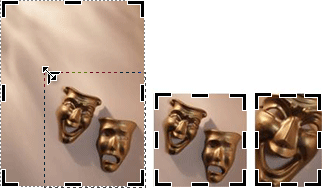
-
Select the clip in your document.
-
Click Picture > Crop
 .
. -
Place the pointer over one of the black crop handles along the edge of the clip. Then click and drag until you have cropped the clip to the area that you want.
Resizing
When you find the perfect clip for your document, it might not be the right size. Because cropping isn't always appropriate, you can enlarge or reduce the clip so that it fits within a certain area. For example, the first clip below was reduced to the second clip.
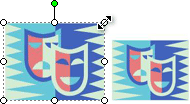
-
Select the clip.
-
Move your pointer over one of the open circles at a corner of the image.
-
Drag until the image is the size that you want.
Note: Dragging an open circle at a corner resizes the image proportionally. If you drag one of the side circles, the image grows or shrinks disproportionately, as shown here.
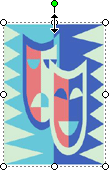
Rotating and flipping
Rotating a clip can enhance a page design by adding a dynamic asymmetry. For example, this mask in its vertical orientation is static and predictable. Rotated slightly, the mask gives the impression of movement (without the distraction of animation).
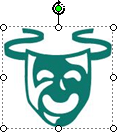
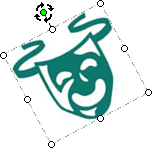
Flipping a clip can provide symmetrical balance to the page. This pair of performers is created by copying the clip on the left and flipping its pasted duplicate on the right. They might serve as bookends for an important headline.

Rotate a clip
-
Select the clip.
-
Click Arrange > Rotate or Flip, and then do one of the following:
-
Click Rotate Left 90° or Rotate Right 90° to rotate the clip in 90-degree increments. Click once to rotate the clip 90 degrees. Continue to click until the clip is in the position that you want.
-
Click Free Rotate, and then place the pointer over the round green handle at the top of the object. When you see a circle around the green handle, drag until the object is at the angle that you want.
-
Flip a clip
-
Select the clip.
-
Click Arrange > Rotate or Flip, and then click Flip Horizontal or Flip Vertical.
Adding a drop shadow
Adding a drop shadow to a clip can give dimension and depth to your publication, and it can provide a professional appearance.
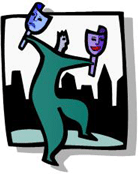
-
Select the clip.
-
Click Formatting > Shadow Style
 , and select the style you want.
, and select the style you want.
Note: To remove a drop shadow, click Shadow Style and then select No Shadow.
Changing contrast and brightness
You can change the appearance of a clip by adjusting the contrast and brightness of the image.
-
Select the clip.
-
On the Picture toolbar, do any of the following:
-
To increase the brightness, click More Brightness
 .
. -
To reduce the brightness, click Less Brightness
 .
. -
To increase the contrast, click More Contrast
 .
. -
To reduce the contrast, click Less Contrast
 .
.
-
Adjust the levels and compare the differences. For example, you can make a clip darker by decreasing the brightness, or you can subdue it by reducing the contrast.
If you want to place the clip behind text, you can wash out the clip by clicking Picture > Color  , and then selecting the Washout option.
, and then selecting the Washout option.
Wrapping the text around a clip
One way to add a professional look is to add text that wraps around an image. The Text Wrapping feature lets you place a clip amid blocks of text.
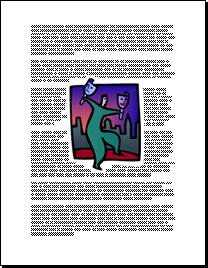
-
Insert the clip in a block of text.
-
With the clip selected, click Picture > Text Wrapping
 , and then click the style of text wrapping that you want to add.
, and then click the style of text wrapping that you want to add.You can wrap text around, over and under, or through a picture. You also can choose to edit the wrap points, which can be useful with irregular shapes.
Tip: You can place the graphic in your document either before or after you add the text, but it may be easier to position the graphic with a text wrap after all of the text is in the document.
No comments:
Post a Comment